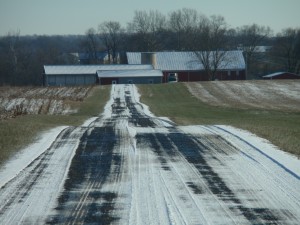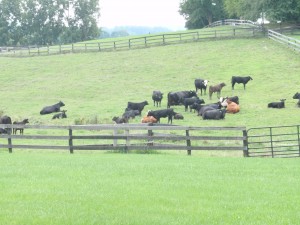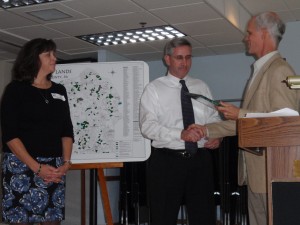Welcome to the Nov. 2010 edition of FPR. Click on the link below for the PDF version. The online version contains slightly more content than the PDF version.
In December, we will be posting minimal online content only.
[download#10]
New York program broke, contracts go unpaid
BY DEBORAH BOWERS, Editor & Publisher
This story was updated Nov. 29.
ALBANY, NY – Nearly half of New York’s 113 approved farmland easement projects with total encumbered funds of $55.4 million are not settled and are more than three years old, according to a report released in Oct. by New York State Comptroller Thomas DiNapoli. About 60 farms have been waiting for payment, but the state has not dispersed the funds that were committed to the projects.
DiNapoli said delayed closings have caused a backlog in the state farmland preservation program, which operates through grants to municipalities and land trusts, but stopped short of placing blame for the delays. DiNapoli recently estimated the New York State deficit is $1 billion.
The program was once funded with $30 million. This year, $10.75 million was in the governor’s enacted budget, but that could be cut in half. No new projects are being accepted.
“The program is in danger of becoming dormant,” said Seth McKee, director of conservation for Scenic Hudson. “There are a lot of farmers sitting around for several years waiting for word.”
McKee said his organization, and others, are pointing out that farmland preservation “is an economic development strategy and should be funded and staffed as such.”
The New York program has never had more than its one fulltime position, filled by David Behm.
The comptroller’s report stated that funds “are not being disbursed in a timely way,” and that “New York State government [should] focus attention on identifying and eliminating the sources of delay.”
According to Peter Paden, executive director of the Columbia Land Conservancy, an applicant to the farmland program, “the problem is, the legislature is not appropriating money. They’ve got an Environmental Protection Fund and year after year they have borrowed from that in order to pay for other things with the intention of paying it back. They would say they would release $33 million dollars and instead only release $20 million or, they would only release, as they did this year, $10 million dollars. In the meantime the Department of Ag & Markets has reviewed projects, signed contracts, made commitments.”
Paden said the department has awarded far more money than has actually been expended.
“The program is seriously underfunded even in the best of times,” Paden said, “compared to the amount of farmland we have in the state, which is good farmland, and compared to the amount of money other states with farmland protection programs spend.”
In a prepared statement, New York Agriculture Commissioner Patrick Hooker said the Farmland Protection Program has $5.5 million worth of projects “fully cleared and ready for disbursement of monies from the Environmental Protection Fund.” He also stated that other projects were underway in the department, but added “we are awaiting information from our farmland protection partners across the state on approximately $50m of proposed projects.”
Phil Giltner, executive assistant to Commissioner Hooker, told FPR completion of the projects is “out of our hands.” Gilter said the backlog “looks worse than it is,” but it was conceivable that allocated but unused funds could “go away” if the state’s fiscal condition caused the legislature to look for funds to fill other program needs.
“You never say never in government. It is conceivable if we don’t have a contract signed, the legislature could sit down and say ‘we need that money.’ Who knows?”
The farmland program is funded with appropriations from the state’s Environmental Protection Fund (EPF) and with bond proceeds from the Clean Water/Clean Air Bond Act of 1996. The New York program has preserved 170 farms and 32,867 acres. Easements are held by municipalities and land trusts. In addition to funding conservation easement purchases at 75 percent of easement cost, the New York program funds planning grants at a 50 percent match. Fifty-three counties and 64 towns have completed farmland protection plans under the program.
The comptroller’s report points out that a 2008 audit of the program found the upfront work of awarding the grants was “transparent and timely,” signifying the blame for the clog in the pipeline rests elsewhere, not in the Department of Agriculture & Markets.
But a number of land trusts feel that the program’s having just one staff person is part of the problem. While other state farmland programs currently have between three and five staff members, “we’ve had one for a long time, and believe me, it takes a long time to get the applications through,” said Peter Paden. “It’s a very poorly supported program, and that’s a resource issue. The legislature hasn’t decided this is sufficiently important.”
In the easement purchase part of the NY program, grants are awarded to municipalities and land trusts, which are responsible for all of the paperwork, including title work, appraisal, survey of the “proposed conservation easement area of the farm,” a project budget, the purchase agreement, the deed of easement, and a monitoring plan. Most municipalities turn over projects to land trusts if there is one in the area. Last year a law was passed to allow land trusts to apply directly to the program. Prior to 2009, municipalities were the applicants, and could turn over projects to land trusts, and any town that had a land trust took that route, according to Paden. “It would be a rare town that could do [the paperwork],” he said.
Governor-elect Andrew Cuomo stated in an agriculture platform brief that his administration would work to address the backlog “although there are no easy solutions because of the state’s fiscal constraints.”
According to the American Farmland Trust’s New York field office, not enough money is in the EPF “to make good on the $71.5 million owed to farm families” that have contracts with the state. AFT said the report from Comptroller DiNapoli, who has been elected to another term, mirrors the support of farmland preservation promised by Gov.-Elect Andrew Cuomo.
“There’s a lack of essential progress, part of it is staffing,” said Scenic Hudson’s Seth McKee, one of the state’s leading land trusts. McKee said the current administration has been supportive of farmland protection at the policy level, but the easement process is cumbersome and has caused some of the backlog.
Beyond the fiscal crisis and the problem of money not being released for committed projects, McKee, and Andy Bicking, Scenic Hudson’s director of public policy, said the future of the program depends on lawmakers seeing the economic importance of farms.
“Part of the issue overall, that we think the comptroller’s report really points to, and that we take great benefit in, is that it clarifies in no uncertain terms, that farmland protection is a very important tool for economic growth and renewal,” Bicking said in an interview. “So there’s value in protecting farms, but there’s a clear economic value and interest for the state to continue this program. The report came on the heels of two years of what was really an all out attack on the notion of private land conservation and the environment in general in New York State. There have been disproportionate cuts to key environmental, agricultural and parks agencies,” Bicking said.
David Haight, director of the American Farmland Trust’s New York field office, said the next budget will be critical to the future of the program and he is working with legislators and the in-coming administration.
“We’ve been reaching out to the governor-elect about options for making good on these commitments,” Haight said. “We’re working to get legislators on board. We’re hopeful but we also recognize the state’s fiscal problems.”
Haight said some farmers have paid more than $10,000 to prepare their easements and he worries that the program is getting a black eye as the waiting game continues with no known resolution.
Both Scenic Hudson president Ned Sullivan and AFT’s David Haight will serve on Gov.-Elect Cuomo’s transition team.
PA preferential assessment law amended for energy production
BY DEBORAH BOWERS, Editor & Publisher
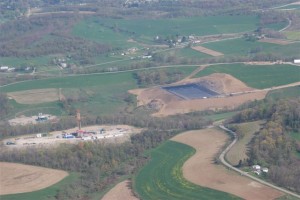
Marcellus shale drill site in Washington County, Pa. ( Source: Fractracker.org)
HARRISBURG PA – In a state where drilling for natural gas in Marcellus Shale regions has changed both the economic and natural landscapes, lawmakers are playing catch-up in matters relating to taxing agricultural properties affected.
Gov. Ed Rendell on Nov. 23 signed Act 109, which will allow property owners whose lands are leased for gas drilling to keep their agricultural-based tax assessment for all acreage except that directly taken up by the drill site.
The booming Marcellus shale gas drilling industry has been at work for several years throughout the western and northern parts of the state.
The New Jersey legislature this year also addressed the taxation of agricultural properties engaged in energy production, passing a law that allows “biomass, solar or wind energy generation” to be considered agricultural uses for property taxation purposes. The Marcellus shale region does not extend into New Jersey.
Pennsylvania’s new law adds to the definition of agricultural use “any land devoted to the development and operation of an alternative energy system, if a majority of the energy annually generated is utilized on the tract.”
According to the Bureau of Farmland Preservation, preserved farms in Pa. retain the right to lease land for gas and oil extraction. Access roads and construction of drilling sites is allowed. Property owners are encouraged, not required, to notify their local farmland protection boards if they receive offers to enter into gas or oil leases.
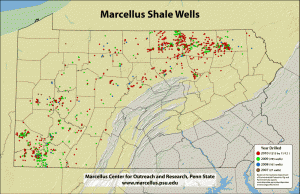
Source: Penn State Marcellus Center for Outreach & Research
Most county-level programs permit farm-based renewable energy if most of the energy is used on the farm, according to the Bureau. Several county programs were amended in recent years to permit farm based renewable energy even if the majority of the energy is sold, provided any associated structures are confined to the area of existing structures.
While the Marcellus shale region doesn’t affect the state’s southeastern counties that contain the great majority of the state’s preserved farms, a number of counties with dozens of drill sites do have preserved farms.
In Centre County, Marcellus drill sites are located currently only in the northern part of the county, while preserved farms and agricultural security areas are in the southern portion of the county.
In Lycoming County, dozens of Marcellus drill sites are scattered throughout the northern portion and in the southeastern corner of the county. Lycoming has about 7,600 acres of preserved farmland.
In Greene County, the state’s most southwestern county and adjacent to West Virginia, the local Soil Conservation District warns farmers on its website, “What we’ve been seeing in the county has been described as a modern gold rush. There are a dozen or more companies in the county that are all vying to lease oil and gas rights. Here at the district we’ve heard about the worst and the best from landowners interactions with the Gas and Oil producers. The best thing you can do is educate yourself before a landman knocks on your door with an offer and a lease for you to sign. First and foremost never sign anything that your lawyer hasn’t looked at first.”
According to Fractracker.org, using data currently being compiled at the University of Pittsburgh, 77 percent of all shale gas being produced in the state is in Greene, Susquehanna, Bradford and Washington counties.
Marcellus drill sites have caused environmental and health concerns, including water and air pollution, and scores of violations have been cited. New standards approved Nov. 18 impose more stringent construction standards on gas wells, according to Pa. Environmental Protection Secretary John Hanger.
In October Gov. Rendell ordered a moratorium on future drilling operations on state forest lands.
This month the Pa. Dept. of Environmental Protection announced it was investigating a spill of waste water from a shale fracturing drill site that had contaminated a stream in Lycoming County. Also this month, The Pennsylvania Infrastructure Investment Authority board (Pennvest) voted to approve $12 million to extend water service to 18 homes in Susquehanna County whose wells, state inspectors said, were contaminated by Marcellus shale drilling. Susquehanna County has about 26 preserved farms and 5,500 acres preserved.
CA appeals court to review farmland mitigation decision
FRESNO, CA – A ruling last year that declared the Stanislaus County farmland mitigation law unconstitutional (see FPR, July 2009) is being reviewed by an appellate court that is expected to decide the matter within a few months. The county’s mitigation law, which requires developers to pay to preserve an acre of land for every acre developed, was passed by Stanislaus County supervisors in 2007.
Farmland mitigation requirements are in use in a number of California cities including Davis, in Yolo County, and Brentwood in Contra Costa County. Davis’ program was the first in the state when approved in 1995. Mitigation programs grew out of Sierra Club lawsuits against cities approving projects that conflicted with master plans. The mitigation payments are used to purchase conservation easements on farmland, sometimes adjacent to developed parcels. Local farm bureaus have supported mitigation programs.
Money is low, interest high in local Maryland programs
FREDERICK, MD – In Maryland, where a number of local farmland preservation programs are funded by revenues from taxes on real estate transfers, local matching dollars for the state program are scarce, but interest remains strong, according to program administrators.
Not only are there fewer transfers of property, but the dollars being paid for property are significantly less, meaning fewer dollars for land protection. The upside is a major slowdown in sprawl, the downside is, a slowdown and backlog in preservation programs.
One real estate expert in Frederick County confirms that farmland not zoned for development is not attracting developers these days, and the value of residential building lots has dropped by more than half.
“Where a perked two-acre rural lot may have sold for $350,000 in 2005, today it may sell for $165,000 or less. In some cases the cost of developing lots exceeds the combined gross value of the finished lots it creates,” Rocky Mackintosh, president of MacRo, Ltd., told FPR.
Mackintosh, who has been in real estate for 40 years, said very few investors are looking for raw land. Such land “is not attractive to the development community … most now will only seek land that is zoned, and will go even further and not actually make the purchase until the approval of an unconditional site plan is achieved…”
Mackintosh, who writes the MacRo Report, said he believes the Frederick market will be strong in the future.
While Macintosh said he felt farmland values had remained fairly stable, Tim Blaser, Frederick program administrator, said he has received calls over the last year about the county’s Critical Farms Program, which helps beginning farmers buy land. But the county program, which depends on real estate transfer tax revenue for funding, is broke.
“I have had a lot of calls about the Critical Farms Program (which also has no funding) due to prospective farmers actually feeling as if they now have a chance to buy some farms now that the boom times are over and there are [fewer] speculators out there competing for those farms.”
“Interest in land preservation is booming” due to fewer development options, Blaser said. “This would be a great time to make headway if we had the money.”
In neighboring Washington County, revenues from the local agricultural transfer tax, a state tax collected locally, is generating “next to nothing” in revenue, said program director Eric Seifarth. The county had 30 applications, but it will depend on state dollars to fund what applications are finally approved. “There is substantial interest. We’ve had several [applications] come in for next year,” Seifarth said.
In Howard County, program activity is the strongest in years, said director Joy Levy. This year the program had 13 applicants and the county was able to make seven offers, she said. “This batch will deplete our funding for a while,” she said.
PROGRAM BRIEFS
In Pennsylvania… The Lebanon County Commissioners last month refused to approve a $325,000 grant to the county conservation district for farmland preservation matching funds, as they looked for ways to close a county budget deficit. It was the first time “in recent memory” the program received no funding, officials said. Funding was also cut for all Conservation District programs, leaving only funding for personnel.
The Farmland Preservation Bureau is working to address concerns of county level administrators who say regulations are not well communicated in easement language, with confusion in the areas of existing structures, the additional allowed residence, and replacement structures. Pennsylvania program administrators met Oct. 27 to go over a “wish list” of improvements to the state program. A draft of revisions will be released to counties in a few months, said Dwight Jared-Smith, department counsel, who attended the meeting.
Three land trusts will talk about how they can work with farmland preservation programs in a roundtable following the next state board meeting Dec. 9. The roundtables are arranged by the Bureau of Farmland Preservation.
In North Carolina … Agriculture commissioner Troxler announced $2 million available for grants in the Agriculture Development and Farmland Preservation Trust Fund with a deadline of Dec. 15.
In Delaware … Program director Michael McGrath announced Oct. 28 at his board meeting that he will retire in June 2011. McGrath has served as chief of planning in the state Department of Agriculture since 1984 and administrator of the state farmland program, the latter position since 1991 when the program first began operating.
In Maryland … Baltimore County program administrator Wally Lippincott recently updated the county’s five land trusts on their balances in county grant money available for land preservation. About $889,000 in awards is currently uncommitted by the land trusts, and $650,000 in additional funds are available. In July 2011 an additional $1 million will be available. Other counties are not faring so well. Neighboring Harford County has no local money for new projects.
In Michigan… A balanced budget was more important to Kent County Commissioners when they voted on their budget, leaving the county’s fledgling PDR program without the level of funds it needs to match private grant monies. The board did allocate $275,000, but that was $75,000 short of the commitment sought by a grant agreement from a private funder.
In Connecticut … Gov. M. Jodi Rell presided for the last time over preservation of a farm this month and announced the state will be preserving 20 farms this year. During her tenure that began in 2004, 74 farms and about 8,000 acres were preserved. The state has preserved a total of about 26,000 acres and 270 farms.
In New York … The Finger Lakes Land Trust preserved 519 acres this month on a farm that grows cabbage, corn, beans and other crops. While the state struggles under a deficit estimated by the comptroller at $1 billion, the deal was sealed with state funds committed in 2008.
Voters approve $2 billion for land & conservation
WASHINGTON, D.C. – Voters across the country Nov. 2 overwhelmingly approved a variety of measures for land conservation, generating a total of $2 billion, according to results tallied by The Trust for Public Land.
Of 35 proposals for conservation funding, 28 passed, for an approval rate of 80 percent, TPL said.
“Yesterday, Americans stepped up and said they want to preserve land and protect clean air, clean water, farm lands, and other natural resources,” said TPL president Will Rogers in a press release following the election.
“It’s the same result we have seen election after election – American voters care about the lands and water where they live, and they’re voting with their wallets. And this support hasn’t changed over the years, despite the challenging economic times we’re living in.”
Rogers called on Congress to follow the lead of voters and approve full funding for the Land and Water Conservation Fund, a perennial fight in the budget arena.
During all of 2010 there were 48 measures, of which 39 passed, for an approval rate of 81 percent.
The measures are tracked by TPL’s Conservation Finance team, which advises state and local governments on conservation funding and helps win approval for measures dedicating funds for parks and conservation. Some examples from around the nation that were noted by TPL:
* In Iowa, voters approved an amendment to the state constitution creating a permanent trust fund to protect and restore natural resources.
* In Maine, voters gave 59 percent approval to a statewide bond that will send $9.75 million to the Land for Maine’s Future (LMF) program, which includes farmland preservation. The program has preserved 26 farms and 7,300 acres. LMF staff and the Department of Agriculture work in partnership to identify farm projects, and fund proposals focused specifically on farmland conservation. The measure was promoted by land trusts, including the Maine Farmland Trust.
* In Oregon, 68 percent of voters approved a measure which indefinitely continues to set aside 15 percent of the revenue generated by the state lottery for protection of water, parks and wildlife habitat. The set-aside provision had been scheduled to expire in 2014 had it not been extended. The provision has generated more than $800 million in the past decade.

Two NC counties get certified farmland protection plans
FORT BRAGG, NC – Farmland protection plans devised for Cumberland and Scotland counties were certified by the state Nov. 11. The plans were developed under a grant to the BRAC (Base Realignment & Closure) Regional Task Force, under its Working Lands Protection Program.
One of the task force’s primary concerns is growth around Fort Bragg, particularly residential growth that puts a pinch on military training exercises. The state certification gives priority status to counties for state grant money for farmland preservation and other funds for land and water conservation. Four other counties in the BRAC region have been certified. The BRAC Regional Task Force is comprised of representatives from 11 counties and 73 municipalities surrounding Fort Bragg and Pope Air Force Base.
“The region’s working lands will help maintain the operational readiness of Fort Bragg and reduce the problems posed by development and other land uses that are incompatible with the Army’s training and operational objectives,” said Greg Taylor, executive director of the BRAC-RTF.
The farmland protection plan for both counties outlines the importance of agriculture and identifies ways to support the industry. The plan also identifies ways to reduce development that may be considered incompatible with the mission of Fort Bragg through preservation of working farms and forests.
Redding: transition planning should follow preserving the farm
GETTYSBURG, PA – Farm transition planning should follow farmland preservation, according to Pa. Agriculture Secretary Russ Redding, speaking before the Pa. Farmland Preservation Association’s (PFPA) twice yearly conference in Gettysburg Oct. 27.
Redding said the Pa. Dept. of Agriculture was the first state department of agriculture to partner with the Farm Journal Legacy Project, an initiative to help farm families pass their farm businesses to the next generation. The department will host a transition planning workshop for producers on Dec. 16 at the state’s Farm Show Complex in Harrisburg. Redding partnered with Andrew Weber, CEO of Farm Journal Media to promote the workshop. The six-hour session is being offered at no cost to attendees.
Redding said farmland preservation administrators, while focusing on getting the preservation deal, “should be every bit as determined” to help farm families plan their estate.
“That’s the most difficult thing to do as a farm family,” Redding told the approximately 25 county-level farmland preservation program directors attending the conference. “It has to be taken on in a very constructive way.”
“We’ve asked these families to step up and restrict their farms in perpetuity. We have to step up now and ask them to focus on their legacy,” Redding said.
In Jan. 2010, Pioneer Hi-Bred, a DuPont firm, announced it would partner with Farm Journal Media to support the Farm Journal Legacy Project in addressing succession planning for “the largest transfer of farm wealth in American history.”
CONFERENCES
Dec. 4, Exton, PA: Leasing Land for Farming, A Workshop for Landholders & Beginning Farmers. “In this workshop for landowners, land trusts, land managers and aspiring or expanding farmers, we will explore new options for leasing land for sustainable farming and learn about “Farm Futures”, a new program linking those with land to folks who want to grow food for human consumption.”
Jan. 13-15, Reisterstown, MD: We Are What We Eat: Community Health Through Sustainable Farming, sponsored by Future Harvest. “The Future Harvest-CASA Annual Conference is a highly anticipated annual gathering for hundreds of farmers, agricultural experts and researchers, marketers and food systems advocates who care about the sustainability of food and farming systems in the Chesapeake watershed.”

Author Wes Jackson
Feb. 3-5, State College, PA: Farming for the Future, annual conference of the Pa. Association for Sustainable Agriculture. Wes Jackson keynote speaker. “The annual Farming for the Future conference is PASA’s signature event and our main vehicle for community building. Widely regarded as the best of its kind in the East, this diverse event brings together an audience of over 2,000 farmers, processors, consumers, students, environmentalists, and business and community leaders annually.”
Feb. 23- 25, Shepardstown, WV: National Green Infrastructure Conference, sponsored by The Conservation Fund. “The Inaugural 2011 National Green Infrastructure Conference is a gathering of policy-makers, practitioners, and on-the-ground implementers of green infrastructure practices and design from around the country. This is the first official conference of the National Green Infrastructure Community of Practice.”
May 19 – 21, Harrisburg, PA: Pennsylvania Land Conservation Conference, sponsored by the Pa. Land Trust Association. See http://www.conserveland.org/conferences.
Preserving a farm in one evening
BY TOM DANIELS, Senior Contributing Editor
Imagine seeing a farm being preserved right before your eyes. No, I don’t mean the signing and shuffling of conservation easements, subordination agreements, and checks. I mean watching donors buy a quarter-acre, a half-acre, or an acre of a farm easement until the entire farm is preserved.
State Representative Scott Boyd, stocky, mustachioed with tie askew, is the auctioneer and behind him is a large map of the farm slated for preservation: a 60-acre farm owned by a member of the Old Order Amish community for which Lancaster County is famous. Boyd will not rest until he has begged, badgered, cajoled, and even sung enough money out of the audience. His tall, slender, and blonde assistant—a Vanna White look-alike—roams the dinner tables searching for willing donors to make a bid with a raised a hand or subtle nod. A full acre goes for $500, a half-acre is $250, and a quarter-acre is $125—all tax deductible.
The place to witness this exciting event is at the annual dinner of the Lancaster Farmland Trust. For each of the past five years, the preservation of a farm has highlighted the Trust’s gathering. The audience of 200 strong—mainly older adults in suits and dresses—come together to celebrate the Trust’s achievements. And they bring their checkbooks for a good cause.
At the 2010 annual dinner, the Trust raised more than $70,000 to preserve its 350th farm, bringing the total number of preserved farms in the county to more than 1,100. Founded in 1988, the Lancaster Farmland Trust has preserved more than 20,000 acres, and has focused on working with Amish farmers who are reluctant to sell or donate an easement to the county government’s farmland preservation program. The Farmland Trust is accredited by the Land Trust Alliance and has preserved over 1,000 acres on 19 farms in the past year.
With public revenues under severe stress from the Great Recession of 2007-2009, it is refreshing to see the private sector raising funds by literally passing the hat at the farm preservation auction. This is community in action.
Keynote speaker Tom Curren of the Pew Charitable Trust primed the audience by noting that, “The land is never going to be less expensive than it is right now.”
The Trust’s annual dinner attracts people from far and wide. At my table was Scott Everett, long-time farmland preservation advocate from Michigan who was leading four county commissioners from Kent County, MI for meetings with Lancaster County farmers and officials about farmland preservation. Next to me was Matt Knepper, Director of the Lancaster County Agricultural Preserve Board, a recent winner of the Trust’s Spirit of Cooperation Award. And next to him was attorney Sam Goodley, Jr., who raises organic beef and goats on a preserved farm, and who also serves on the Farmland Trust’s Board of Trustees.
Wendell Berry once remarked that no farm was ever preserved in an air conditioned room. But the farm preservation auction in a large hotel dining room came pretty close. As the motto of the Lancaster Farmland Trust says, “We’re piecing together the landscape, one farm at a time.”
Tom Daniels is FPR’s senior contributing editor. He teaches planning and land conservation at the University of Pennsylvania and is author of When City & Country Collide and other books.
Why do we do what we do so well?
BY MIKE MCGRATH, Contributing Editor
After several articles suggesting why and how to grow our preservation programs, I wanted to try and provide some insights in answering the big question – WHY?
Why do people spend their lives trying to preserve and protect America’s vanishing farmland? To those of us laboring in the vineyard it may come as a surprise that to many the answer is not obvious. It is a question worth answering. I won’t even try to cover all the reasons that we could give for preserving farms – just a few of the better ones. Ones that we can use when we are asked about the hope which is within us!
Food has to remain one of the key reasons to preserve farms. When I first heard about farmland preservation in the 70s it was couched in terms of the need to insure enough land to supply the nation’s food. Bob Gray, assistant to Congressman Jim Jeffords of Vermont during the Carter administration, spearheaded the National Agricultural Lands Study, published in 1980, that had as a central purpose understanding how land loss was affecting our ability to produce food. But it wasn’t long before most people were downplaying the need to preserve land for food. The globalization of agricultural production seemed to make that a moot point. We could simply buy food from other places in the world if we ran short of land in America. But people still had a hard time forgetting the Teamsters’ national strike that resulted in empty store shelves in New England. That history was a reminder that food from far away was tenuous. It drove the early interest in New England in protecting and preserving farms. Nationally, food security would come back later as one of the key reasons to preserve local farms.
Two changing tides are now pushing the issue to the forefront again. First, the aftermath of 9/11. Food system security looms large in the post-9/11 world. We want to know where our food comes from, that it is safe, and that we are not putting our food supply in the hands of potentially unfriendly forces. As I’ve said recently, “If you think people will kill each other over oil, watch what they do over dinner!” The second major tide sweeping the country is the local/sustainable food movement. It’s still a small movement, but more and more shoppers are looking to support local agriculture. They want fresh food that tastes good! Farmland preservation comes right behind that movement. When Wal-Mart starts stressing the sustainable approach it’s time to pay attention!
Today, a cost-efficient government is at the top of the political agenda both at the national and state levels. Farmland preservation can play a key role in holding down the costs attendant to uncontrolled sprawl. Several years ago Delaware’s Secretary of Transportation said in a public meeting, “For every dollar we spend on land preservation, we can save ten dollars in transportation infrastructure.” It was a bombshell! Since then our analysis in Delaware has clearly demonstrated that sprawling development proportionally drives up capital costs and expenses for geographically sensitive services. We can all be motivated, conservative and progressive, by public savings resulting from preserving farms and open space.
Those of us working with landowners every day are driven by the sincere intentions of these owners to give up much in order to see their land preserved. Our programs to preserve farmland help these owners realize their dream of insuring that this land will remain forever in agriculture. Our work is ennobled by the sincerity of these decisions that, more often than not, cost the owners hundreds of thousands, if not millions, of dollars. In a world of six-figure bonuses, money-grubbing public figures and the “what’s-in-it-for-me” mentality, these farmers are an inspiration. And the public responds positively to these motivations, as well. I recall the comments of one of the attorneys that handled most of our closings here in Delaware in the early days (now a leading Delaware judge). After one of the first closings he came to me and said, “Mike, I can’t believe it. We just handed this couple more than a million dollars and I’m pretty sure that tomorrow they’re going to get up, go to work on the farm, and do the same things they did yesterday! They were so happy to see this farm preserved – they didn’t even look at the check! I love this work better than anything I’ve ever done as an attorney!” Yes, it’s inspiring and makes it easy to come to work every day!
Finally, I wanted to mention something that motivates many of us to do this work – the love of the farm. Now, this is hard to describe; but if you feel it, you’ll know what I mean. There’s just something about a farm. The growing crops, the animals grazing in the fields, the chickens clucking in the houses, the farmer going out at the break of dawn and climbing onto a tractor – all of it is, well, wonderful! It doesn’t matter what part of the country, what the crops, what the animals – it’s just magical. There is a beauty and peace and satisfaction in looking across a plowed field or waving grain or ripening vegetables and knowing it will be that way forever. This feeling goes beyond the food, or the balance sheet, or the temporary pleasure of ownership – it is transcendent and touches some of the deepest chords in the human psyche.
We who have a hand in preserving these farms can reap a satisfaction that few people can ever feel in a mere “job.” We are involved in keeping in this country one of the real touchstones of our civilization. Daniel Webster once said in a speech, “When tillage begins, other arts follow. The farmers, therefore, are the founders of human civilization.” If he was correct, and I believe he was, then we who toil in the vineyard of preservation are the protectors of human civilization.
That should make it easy to get up tomorrow and go to work!
Mike McGrath is executive director of the Delaware Agricultural Lands Preservation Foundation.
